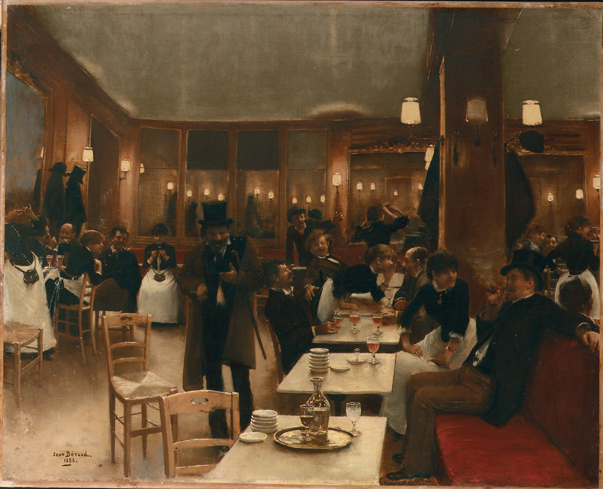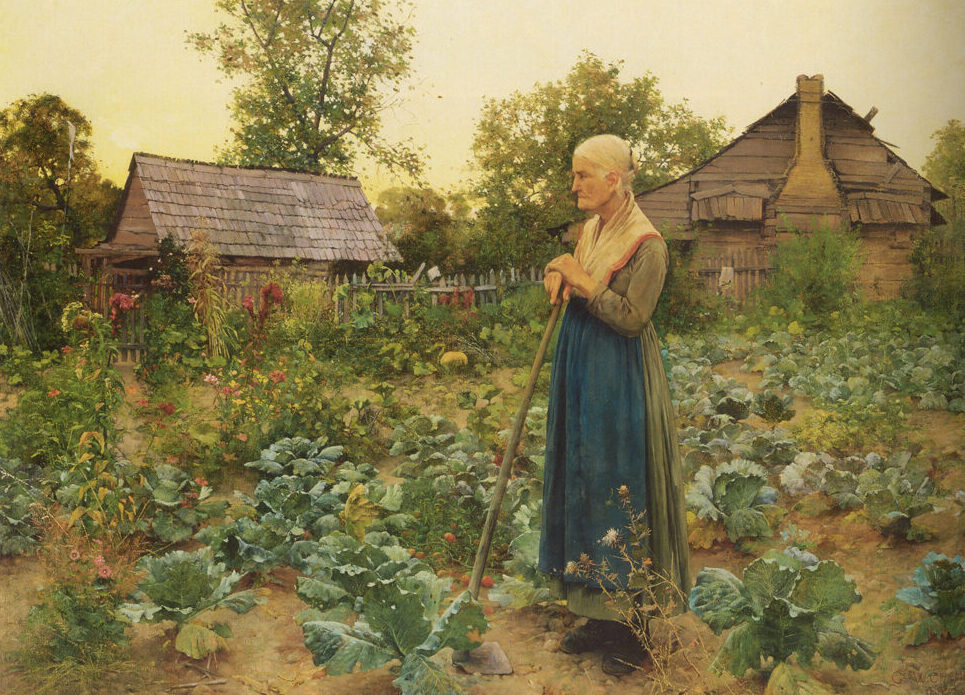Farm to Table: Art, Food, and Identity in the Age of Impressionism
Tennessee Harvest: 1870s–1920s
January 31–May 4, 2025
NASHVILLE, Tenn. (December 5, 2024)—The Frist Art Museum presents Farm to Table: Art, Food, and Identity in the Age of Impressionism and Tennessee Harvest: 1870s–1920s, two companion exhibitions that explore the intersections of art, gastronomy, and identity. Both exhibitions will be on view in the Frist’s Ingram Gallery from January 31 through May 4, 2025.
Farm to Table, organized by the American Federation of Arts and the Chrysler Museum of Art, Norfolk, Virginia,focuses on late 19th-century France and showcases the work of artists such as Rosa Bonheur, Gustave Courbet, Paul Gauguin, Claude Monet, and Camille Pissarro, who captured the nation’s unique relationship with food, from production to preparation and consumption.
Featuring paintings and sculptures that span the age of impressionism, the nearly 60 works in Farm to Table depict a wide gamut of human relationships to food. Throughout the exhibition are portrayals of farmers in fields, chefs and diners in cafés, and scenes ranging from agrarian crises to bountiful harvests and humble fare to luxurious meals.
“France’s reputation as the world’s culinary capital became increasingly important as it grappled with war, political instability, imperialism, and industrialization,” writes exhibition curator Andrew Eschelbacher. “In this climate, France’s culinary traditions signaled notions of its refinement, fortitude, and ingenuity while also exposing fractures in French society.”
Organized into five thematic sections, the exhibition begins with images of farming and husbandry such as Claude Monet’s The Haystack and Auguste Renoir’s scene of banana trees in the French colony of Algeria, raising questions about the concepts of terroir (the soil, which was said to give French food and wines their distinctive qualities) and how “Frenchness” was defined.
In subsequent sections are paintings of markets, shops, and food workers like butchers, cooks, and servers—some revealing gendered divisions of labor and interactions between different classes. These works underscore the socioeconomic dynamics between urban and rural areas, as well as wartime hardships such as those seen in Narcisse Chaillou’s A Rat Seller during the Siege of Paris in 1870.
Still life paintings of meat, fish, fruits, and vegetables contain symbolic social messages. Frist Art Museum’s chief curator Mark Scala notes, “Gustave Courbet’s austere 1872 still life of roughly painted fruit, for instance, showed his solidarity with working class people and their humble fare. In other paintings, cuts of meat acted as stand-ins for the body and served as allusions to both revolutionary violence and medical research.”

25 3/4 x 32 in. Private collection
The final section of Farm to Table showcases the places where French men and women consumed meals, meager or extravagant. “While hunger and poverty were social realities that could not be ignored, this was the age of the grand banquet, the maturation of the restaurant, and an era of picnics and rural feasts,” writes Eschelbacher. “In these spaces, questions of family, community, citizenship, and spectacle come to the fore, speaking to the evolving social identities of a people who had long been told that what they ate—and how they ate it—defined who they were.”
Tennessee Harvest: 1870s–1920s
Organized by the Frist Art Museum, Tennessee Harvest was co-curated by Mark Scala and Candice Candeto, senior curator of fine and decorative art, Tennessee State Museum. The exhibition shows connections between paintings made in Tennessee or by Tennesseans and artworks in Farm to Table: Art, Food, and Identity in the Age of Impressionism.
The exhibition features 16 works by 19th- and early 20th-century painters including Lloyd Branson, George W. Chambers, Gilbert Gaul, Cornelius Hankins, Willie Betty Newman, Catherine Wiley, and others who absorbed and adapted European influences in both subject matter and style, using realist and impressionist approaches to the depiction of food and its cultivation in the state.
As with their French counterparts, these Tennessee artists often romanticized agricultural life. Showing strong, hard-working farmers and harvesters, they celebrate rural self-sufficiency and resiliency. Intentionally or not, this reinforced the perception of the turn-of-the-century South as a distinctly agricultural economy, even as manufacturing and other industries were on the rise. The paintings also warrant study for subjects they omit—Black farmers, markets, and cooks. To present a more complete view, the exhibition will include photographs showing the broader realities of food production across the state.
“Although new schools, art societies, and galleries were opening in cities like Knoxville and Nashville, artists frequently left Tennessee for cities like Munich, New York, or Paris to study at professional academies and see examples of European art in museums, salons, and artists’ ateliers,” writes Scala.
Direct connections to French painting can be seen in works by several artists in Tennessee Harvest, especially between George W. Chambers’ In the Tennessee Mountains, depicting an aged woman standing in a cabbage patch that she has cultivated, and his teacher Julien Dupré’s 1884 Haying Scene in Farm to Table, showing a woman laboring in the fields. Other painters like Willie Betty Newman, who had studied with the French academic painter William-Adolphe Bouguereau, completed the work The Frugal Repast in France in the 1890s. Although he hadn’t studied art in France, Lloyd Banson was influenced by Barbizon painters, as is evident in Women at Work.

Impressionism generally did not appear in Tennessee until after 1900, and in this exhibition, the style is epitomized by Catherine Wiley’s Morning Milking Time and Newman’s Still Life with Apple and Green Goblet, both featuring the visible brushwork and shimmering light typical of impressionist painting. “Whatever style the artists in Tennessee Harvest used, their sympathies with farm life remained consistent,” says Scala. “They celebrated agriculture as the foundation of all culture, fulfilling needs both physical and spiritual.”
An audio tour for both exhibitions will feature members of Nashville’s diverse food community reflecting on selected works in the exhibition, including representatives from Bloomsbury Farms, the Nashville Food Project, Second Harvest Food Bank, and several local restaurants.
Martin ArtQuest, the Frist’s award-winning art-making space, will feature new stations highlighting the techniques, materials, and inspirations associated with impressionism, including still life and oil pastel activities.
Program
Opening Conversation: Farm to Table
Presented by Andrew Eschelbacher and Mark Scala
Thursday, January 30, 6:30 p.m.
Gallery admission required
Join Andrew Eschelbacher, director of collections and exhibitions at the Amon Carter Museum of American Art, and Mark Scala, chief curator at the Frist Art Museum, for this conversation about Farm to Table.
Eschelbacher is the curator and editor of Farm to Table: Art, Food, and Identity in the Age of Impressionism, and has previously curated exhibitions and edited catalogues including Monuments and Myths: The America of Sculptors Augustus Saint-Gaudens and Daniel Chester French as well a A New American Sculpture: Lachaise, Laurent, Nadelman, and Zorach. He holds a PhD and master of arts in art history from the University of Maryland, College Park and Tulane University, respectively, as well as a bachelor of arts from Davidson College.
Exhibition Credit
Farm to Table: Art, Food, and Identity in the Age of Impressionism is organized by the American Federation of Arts and the Chrysler Museum of Art.
About The American Federation of The Arts: The American Federation of Arts (AFA) is a leader in traveling exhibitions internationally. A nonprofit organization founded in 1909, the AFA is dedicated to enriching the public’s experience and understanding of the visual arts through organizing and touring art exhibitions for presentation in museums worldwide, publishing exhibition catalogues featuring important scholarly research, and developing educational programs.
About The Chrysler Museum of Art: The Chrysler Museum of Art brings art and people together through experiences that delight, inform, and inspire. Internationally recognized for its collection of more than 35,000 objects, including one the largest glass collections in America, the Museum also includes free admission, the state-of-the-art Perry Glass Studio, a full-service restaurant, shop, theater, works on paper space, and oversees the historic Myers House. The Museum boasts an ambitious schedule of exhibitions, events, and programs, and has been nationally recognized for its commitment to inclusion through its innovative gallery host program. For more information, visit chrysler.org. Follow on social media @ChryslerMuseum to receive the latest updates.
Tennessee Harvest: 1870s–1920s is organized by the Frist Art Museum and co-curated by Mark Scala, Chief Curator, Frist Art Museum, and Candice Candeto, Senior Curator of Fine and Decorative Art, Tennessee State Museum.
Farm to Table: Art, Food, and Identity in the Age of Impressionism is generously supported by Martha MacMillan and Monique Schoen Warshaw. Additional support has been provided by Betsy S. Barbanell, Lee White Galvis, Allan Green, Clare E. McKeon, Betsy Pinover Schiff, the Gladys Krieble Delmas Foundation, the Dr. Lee MacCormick Edwards Charitable Foundation, and the Julia Child Foundation for Gastronomy and the Culinary Arts. This project is supported in part by the National Endowment for the Arts.
Platinum Sponsor: HCA Healthcare/TriStar Health
Education and Community Engagement Supporter: Windgate Foundation
Supported in part by the Frist Art Museum’s 2025 Frist Gala Patrons
The Frist Art Museum is supported in part by The Frist Foundation, the Tennessee Arts Commission, andthe National Endowment for the Arts.
Connect with us @FristArtMuseum #TheFrist
FOR ADDITIONAL INFORMATION
Buddy Kite: 615.744.3351, bkite@FristArtMuseum.org
Ellen Jones Pryor: 615.243.1311, epryor@FristArtMuseum.org


